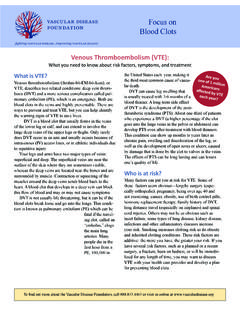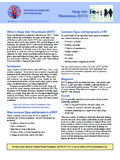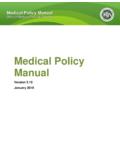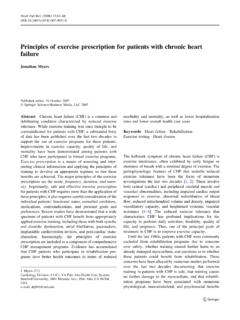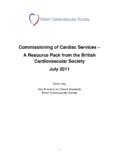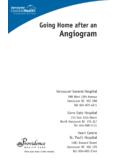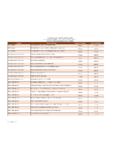Transcription of PAD EXERCISE TRAINING TOOLKIT - Vascular Cures
1 PAD EXERCISE TRAINING TOOLKITA G U I D E F O R H E A L T H C A R E P R OF E S S I O N A L SP A D E xE R C I S ETR A I N I N GTO O LkI T: A G U I D E F O R H E A LT H C A R E P R O F E S S I O N A L SPA G E2 PAD EXERCISETRAINING TOOLKITH ealthy StepsF O R P E R I P H E R A L A R T E Ry D I S E A S EA G U I D E F O R H E A L T H C A R E P R O F E S S I O N A L SThis TOOLKIT was developed jointly by the Vascular Disease Foundation (VDF) and the American Association of Cardiovascular and Pulmonary rehabilitation (AACVPR).Please note that this TOOLKIT is intended to be an online resource. 2016 Vascular CuresNo part of this TOOLKIT may be reproduced without permission from the Vascular Disease TOOLKIT was developed to allow cardiac rehabilitation and other EXERCISE and rehabilitation health care professionals to work within their communities to improve access to supervised EXERCISE programs for people with intermittent claudication resulting from peripheral artery disease (PAD).
2 Clinical practice guidelines and performance measures for adults with PAD stress the importance of supervised EXERCISE to improve functional capacity, decrease symptoms and achieve systemic risk-reduction benefits. The TOOLKIT includes information for EXERCISE and rehabilitation professionals to implement appropriate and safe supervised EXERCISE programs. It also includes practical tools such as sample brochures plus participant and staff education materials. This TOOLKIT was developed jointly by the Vascular Disease Foundation (VDF) and the American Association of Cardiovascular and Pulmonary rehabilitation (AACVPR).P A D E xE R C I S ETR A I N I N GTO O LkI T: A G U I D E F O R H EA L T H C A R E P R O F E S S I O N A L ST A B L E O F C O N T E N T S / I N T R OD U C T I O NPA G E3 PAD EXERCISE TRAINING TOOLKITTAbLE Of CONTENTSC hapter 1: Rationale for EXERCISE Trainingin People with PAD.
3 Page 4 Chapter 2: Differential Diagnosis .. Page 5 Chapter 3: Pathophysiology and Evidenced-Based Guidelines .. Page 6 Chapter 4: Medical Clearance for EXERCISE .. Page 8 Chapter 5: Pre- EXERCISE Evaluation of Functional Cardiovascular Response .. Page 9 Chapter 6: Design of the PAD EXERCISE TRAINING Program .. Page 10 Chapter 7: Interventional Treatment for Page 12 Chapter 8: Outcomes Page 15 Chapter 9: Administrative Considerations for Developing a PAD EXERCISE TRAINING Page 18 Chapter 10: Resources for Health Care Page 27 Chapter 11: Staff Education Page 33 Chapter 12: Sample Marketing Page 34 Chapter 13: Resources for Page 35 Acknowledgements .. Page 36 Healthy StepsF O R P E R I P H E R A L A R T E Ry D I S E A S EA G U I D E F O R H E A L T H C A R E P RO F E S S I O N A L SPAD is the result of systemic atherosclerosis.
4 The underlying disease process that affects the blood vessels is common to patients with coronary artery disease (CAD), stroke and diabetes mellitus. For example, many people undergoing coronary angiography have previously unrecognized PAD. Health care professionals working in rehabilitation or medical fitness programs need to understand the common coexistence of CAD, cerebrovascular disease and PAD, how EXERCISE therapy can benefit program participants with PAD, and how they can develop EXERCISE programs specifically designed for those with PAD, incorporating strategies for modifying the EXERCISE prescription in the presence of existing co-morbidities such as CAD. The most comprehensive clinical practice guidelines about PAD were published in 2006 by a writing group representing multiple organizations, the ACC/AHA Practice Guidelines for Management of Patients with PAD: Click to download the ACC/AHA guidelines accompanying set of slides for these guidelines is very helpful to understand incidence, pathophysiology, differential diagnosis and treatment of to download the slide TOOLKIT directs readers to specific pages of the practice guidelines for more detailed information, when appropriate.
5 Both the guidelines and slides are available to the public on the ACC websites in the links listed A D E xE R C I S ETR A I N I N GTO O LkI T: A G U I D E F O R HE A L T H C A R E P R O F E S S I O N A L S PA G E4 Some of those utilizing this TOOLKIT may not be familiar with the clinical characteristics of the common PAD patient. Here is some basic information to help you better understand the patient population effected by chance of having PAD increases as you get older. People over age 50 have a higher risk for PAD and the majority of patients will fall in this demographic. One in 20 adults over age 50 and one in five over age 70 will have PAD. A person s risk increases with these factors: Current or previous tobacco use Diabetes High blood pressure Abnormal blood cholesterol levels African American ethnicity Heart disease, heart attack or strokeRATIONALE fOR EXERCISE TRAININGIN PEOPLE wITh PADH ealthy StepsF O R P E R I P H E R A L A R T E Ry D I S E A S EAB O U TT H EPAD PATIENTCHAPTER 1 People with PAD may be asymptomatic or complain of exertional leg discomfort.
6 Some present with the classic symptom of intermittent claudication (IC). This is activity-induced pain, aching or cramps in the calves, thighs or buttocks, which typically occurs during walking and resolves after a few minutes of rest or 5-10 minutes. Others present with atypical claudication-like symptoms which are exertional but do not consistently resolve with rest. More severe forms of PAD, such as critical limb ischemia, produce symptoms which include ischemic rest pain, non-healing wounds or gangrene and commonly require surgical or percutaneous intervention. The symptoms of claudication from PAD can be confused with symptoms from other diseases of the lower extremities, including osteoarthritis, neuropathy, sciatica, myopathy and spinal stenosis. Useful signs and symptoms to differentiate these diseases are included in the ACC/AHA Practice Guidelines for the Managementof Patients with PAD.
7 View the guidelines by clicking recommending an EXERCISE program for PAD, it is important to confirm that the exertional leg pain experienced by the participant is caused by arterial insufficiency ( , IC) and is not a symptom caused by another co-morbid condition such as those listed in Table 4 in the link above. IC generally improves with the EXERCISE program described in this TOOLKIT , whereas symptoms resulting from other conditions will not. Lower extremity PAD can be readily diagnosed using the ankle brachial index (ABI), which is a ratio of systolic blood pressure measured in the ankle and brachial arteries. Interpreting the AbI:Noncompressible > AbI (equivocal) Mild to Moderate Impairment Severe Impairment < often evaluate specific peripheral artery anatomy with other tests such as ultrasonography, computed tomographic angiography (CTA), magnetic resonance angiography (MRA), or conventional angiography.
8 Post- EXERCISE ABIs, measured immediately after walking on the treadmill, can also be used to confirm the diagnosis. These methods are summarized in the ACC/AHA Practice Guidelines for the ManagementManagement of Patients with the guidelines by clicking A D E xE R C I S ETR A I N I N GTO O LkI T: A G U I D E F O R H EA L T H C A R E P R O F E S S I O N A L S PA G E5 DIffERENTIAL DIAGNOSISH ealthy StepsF O R P E R I P H E R A L A R T E Ry D I S E A S ECHAPTER 2(Symptoms may occur at rest)Whether they have leg symptoms or not, people with PAD and IC have significant functional impairment with regard to ambulatory activity. In contrast to angina resulting from CAD where cessation of EXERCISE is recommended when pain occurs, with PAD it is recommended that participants EXERCISE to the point of mild to moderate though not severe leg discomfort.
9 This may be counter-intuitive because exercising to the point of myocardial ischemic pain before stopping is not safe for patients with heart disease, given the risk of ischemic-induced arrhythmias. However, there are benefits to exercising into mild to moderate claudication pain with little risk to the leg or cardiovascular system. In fact, exercising to the point of discomfort from IC may be an important aspect of an EXERCISE TRAINING protocol for participants with IC, as it may contribute to the physiological adaptive changes needed for TRAINING effect. Unfortunately, the average person with PAD who feels pain when walking may cut back on activities that cause discomfort, resulting in further deconditioning, worsening cardiovascular (CV) risk factors, loss of leg strength and eventually disability.
10 P A D E xE R C I S ETR A I N I N GTO O LkI T: A G U I D E F O R HE A L T H C A R E P R O F E S S I O N A L S PA G E6 Healthy StepsF O R P E R I P H E R A L A R T E Ry D I S E A S ECHAPTER 3 PAThOPhySIOLOGy AND EvIDENCED-bASED GuIDELINESD econditioning andworsening:Obesity, HypertensionHyperlipidemiaHyperglycemiaT hrombotic riskImpaired walking abilityDecreased quality of lifePoor aerobic capacityReduced muscle strength and enduranceAltered muscle metabolismAcylcarnitine accumulationAltered electron transportMuscle ber denervationMuscle ber atrophyAltered myosin heavy chain expressionEndothelial dysfunctionPeripheral arterial diseaseReduced oxygen deliverySystematic in ammationFree radical generationIschemicReperfusionProspective studies and meta-analyses have consistently shown that supervised EXERCISE TRAINING for participants with IC increases their walking distances, quality of life and overall functional capacity.


